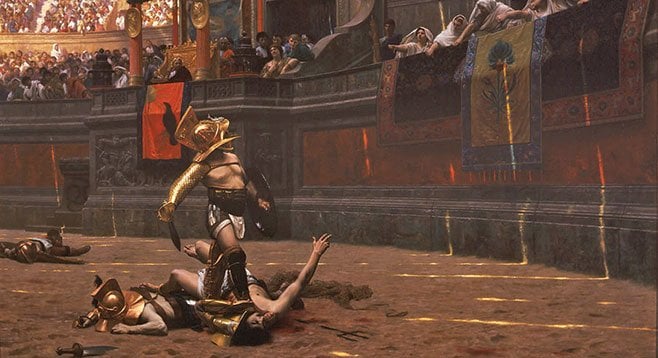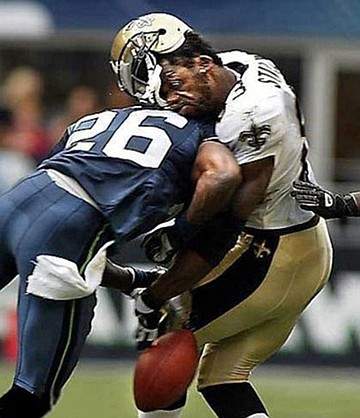 Facebook
Facebook
 X
X
 Instagram
Instagram
 TikTok
TikTok
 Youtube
Youtube

Bread and circuses. Back in the Roman Empire, those were the keys to diverting the public’s attention from political greed and corruption — and, particularly, from the massive gap between the rich and the poor.

Rome won so many wars that it was overrun with captured slaves, and they performed the physical labor. Idle, unemployed Romans were restive. Julius Caesar perfected the ideal appeasement: give them wheat to eat and violent entertainment to savor — or, bread and circuses (panem et circenses).
It worked. Generally, the plebeians neither starved nor rioted. Salivating, they would watch gladiators slaughter animals and each other. Those gladiators were mainly slaves, but as they won laurels, they could win their freedom and rake in donations from the crowd.
In short, violence in the sporting world could be their ticket to riches. Or mutilation. It was a gamble.
Can you see any parallels with our society? (Julius Caesar had never heard of chronic traumatic encephalopathy, or CTE.)

You have to wonder if the same political strategy — bread and circuses — is at work in the United States to keep the people from reacting to ugly truths, such as 95 percent of the economic gains in this recovery have gone to the richest 1 percent, and the majority of National Football League owners are billionaires but get taxpayers to plunk down 70 to 80 percent of the cost of new stadiums.
The professional sports leagues are joined at the hip with federal, state, and local governments. Do you suppose today’s bread and circuses constitute a covert politician/pro-league plan to pacify the proletariat?
Is the United States as bloodthirsty as ancient Rome? The Minnesota Orchestra, one of the nation’s best, was silenced for 15 months in a lockout, and its internationally celebrated music director resigned, although there is hope he will return. In negotiating a settlement, the players took an average annual salary cut from $135,000 to $118,000.
The orchestra’s deficit was $6 million. Over the lockout period, the Minnesota Vikings football team managed to wangle $500 million in taxpayer money for a stadium. Some civilized people spoke up. Former governor Arne Carlson said that if the state could come up with hundreds of millions for the football team, couldn’t it scrape up $6 million to help the orchestra? “The orchestra is a vital state asset that should receive the same attention as the stadium,” said Carlson. Current governor Mark Dayton agreed with Carlson. But the two were lonely voices.
Consider Detroit. Right around the time it became the nation’s largest municipal bankruptcy, the state okayed a $650 million hockey arena for the Detroit Red Wings. Roughly half the money will come from taxpayers. The team owner is the Ilitch family of Little Caesars Pizza renown, which also owns the Detroit Tigers and a big chunk of a downtown gambling casino. Forbes magazine says the Ilitch clan is worth $3.2 billion.
Early in the Detroit bankruptcy, there erupted a battle that might have made even Julius Caesar gulp. The Detroit Institute of Arts houses city-owned art worth $421 million to $805 million. (It also holds many other pieces owned by individuals.) These city-owned pieces are works by great artists: Bruegel the Elder, Degas, Van Gogh, Matisse. The city’s emergency manager hired Christie’s to appraise the art, with the idea it could be sold to help rescue the city. (The institute and several foundations are attempting to raise hundreds of millions to rescue this art museum.)
But this is still a long shot. Creditors claim the art is undervalued. Other hurdles remain.
But there are no hurdles for the hockey arena and the gladiators who will slug and slash their opponents therein. That huge subsidy is going forward.
Hamilton County, Ohio (Cincinnati’s home), whacked $24 million over two years from its health and human services budget and $119 million from schools, partly to cover $33 million in debt service it owes on heavily subsidized stadiums in which the Bengals (football) and Reds (baseball) play.
In August of 2005, Hurricane Katrina devastated New Orleans. Thousands of people were stranded; almost 2000 died. What was one of the first orders of business? The Superdome, where the New Orleans Saints play, was completely refurbished. The cost was $336 million — $156 million from the Federal Emergency Management Agency and $121 million from the state. The 2013 Super Bowl was played there. It is hailed as a great rescue operation while neighborhoods continue to wither and die. The indoor stadium is now called the Mercedes-Benz Superdome. The Saints’ owner is a billionaire.

Pro sports, particularly football, are closely tied to the gambling industry. However, the pro leagues keep denying that they sanction gambling, even though owners are notorious high rollers. Las Vegas is home to no professional teams, but it has been batting around plans for a $900 million football stadium, a $390 million arena, and a number of similar proposals. If a stadium or arena is actually built, but no team shows up, owners trying to hoodwink taxpayers in other cities can always threaten to move to Vegas.
San Diego has a $2.3 billion pension deficit and a $1 billion (or more) infrastructure deficit, and plunks $275 million a year into the pension fund. Yet the family that owns the Chargers is pushing for a stadium that will probably drain the city of $700 million or more. That’s money San Diego simply does not have — unless citizens are willing to put up with pothole-pockmarked streets, ancient sewer and storm-drain pipes, sewer backups, water shortages, higher taxes, and run-down neighborhoods as a tradeoff to subsidize a football team owned by out-of-town billionaires. Local politicians and the daily newspaper enthusiastically back a massive giveaway. Tragically, that is no surprise.
Bottom line: team owners and federal, state, and local governments work together to provide the violence-sated circuses. Stadium subsidies generally involve tax breaks for the team, and the NFL’s administration is considered a nonprofit that is not taxed, thanks to an obsequious Congress.
Hail Caesar!


Bread and circuses. Back in the Roman Empire, those were the keys to diverting the public’s attention from political greed and corruption — and, particularly, from the massive gap between the rich and the poor.

Rome won so many wars that it was overrun with captured slaves, and they performed the physical labor. Idle, unemployed Romans were restive. Julius Caesar perfected the ideal appeasement: give them wheat to eat and violent entertainment to savor — or, bread and circuses (panem et circenses).
It worked. Generally, the plebeians neither starved nor rioted. Salivating, they would watch gladiators slaughter animals and each other. Those gladiators were mainly slaves, but as they won laurels, they could win their freedom and rake in donations from the crowd.
In short, violence in the sporting world could be their ticket to riches. Or mutilation. It was a gamble.
Can you see any parallels with our society? (Julius Caesar had never heard of chronic traumatic encephalopathy, or CTE.)

You have to wonder if the same political strategy — bread and circuses — is at work in the United States to keep the people from reacting to ugly truths, such as 95 percent of the economic gains in this recovery have gone to the richest 1 percent, and the majority of National Football League owners are billionaires but get taxpayers to plunk down 70 to 80 percent of the cost of new stadiums.
The professional sports leagues are joined at the hip with federal, state, and local governments. Do you suppose today’s bread and circuses constitute a covert politician/pro-league plan to pacify the proletariat?
Is the United States as bloodthirsty as ancient Rome? The Minnesota Orchestra, one of the nation’s best, was silenced for 15 months in a lockout, and its internationally celebrated music director resigned, although there is hope he will return. In negotiating a settlement, the players took an average annual salary cut from $135,000 to $118,000.
The orchestra’s deficit was $6 million. Over the lockout period, the Minnesota Vikings football team managed to wangle $500 million in taxpayer money for a stadium. Some civilized people spoke up. Former governor Arne Carlson said that if the state could come up with hundreds of millions for the football team, couldn’t it scrape up $6 million to help the orchestra? “The orchestra is a vital state asset that should receive the same attention as the stadium,” said Carlson. Current governor Mark Dayton agreed with Carlson. But the two were lonely voices.
Consider Detroit. Right around the time it became the nation’s largest municipal bankruptcy, the state okayed a $650 million hockey arena for the Detroit Red Wings. Roughly half the money will come from taxpayers. The team owner is the Ilitch family of Little Caesars Pizza renown, which also owns the Detroit Tigers and a big chunk of a downtown gambling casino. Forbes magazine says the Ilitch clan is worth $3.2 billion.
Early in the Detroit bankruptcy, there erupted a battle that might have made even Julius Caesar gulp. The Detroit Institute of Arts houses city-owned art worth $421 million to $805 million. (It also holds many other pieces owned by individuals.) These city-owned pieces are works by great artists: Bruegel the Elder, Degas, Van Gogh, Matisse. The city’s emergency manager hired Christie’s to appraise the art, with the idea it could be sold to help rescue the city. (The institute and several foundations are attempting to raise hundreds of millions to rescue this art museum.)
But this is still a long shot. Creditors claim the art is undervalued. Other hurdles remain.
But there are no hurdles for the hockey arena and the gladiators who will slug and slash their opponents therein. That huge subsidy is going forward.
Hamilton County, Ohio (Cincinnati’s home), whacked $24 million over two years from its health and human services budget and $119 million from schools, partly to cover $33 million in debt service it owes on heavily subsidized stadiums in which the Bengals (football) and Reds (baseball) play.
In August of 2005, Hurricane Katrina devastated New Orleans. Thousands of people were stranded; almost 2000 died. What was one of the first orders of business? The Superdome, where the New Orleans Saints play, was completely refurbished. The cost was $336 million — $156 million from the Federal Emergency Management Agency and $121 million from the state. The 2013 Super Bowl was played there. It is hailed as a great rescue operation while neighborhoods continue to wither and die. The indoor stadium is now called the Mercedes-Benz Superdome. The Saints’ owner is a billionaire.

Pro sports, particularly football, are closely tied to the gambling industry. However, the pro leagues keep denying that they sanction gambling, even though owners are notorious high rollers. Las Vegas is home to no professional teams, but it has been batting around plans for a $900 million football stadium, a $390 million arena, and a number of similar proposals. If a stadium or arena is actually built, but no team shows up, owners trying to hoodwink taxpayers in other cities can always threaten to move to Vegas.
San Diego has a $2.3 billion pension deficit and a $1 billion (or more) infrastructure deficit, and plunks $275 million a year into the pension fund. Yet the family that owns the Chargers is pushing for a stadium that will probably drain the city of $700 million or more. That’s money San Diego simply does not have — unless citizens are willing to put up with pothole-pockmarked streets, ancient sewer and storm-drain pipes, sewer backups, water shortages, higher taxes, and run-down neighborhoods as a tradeoff to subsidize a football team owned by out-of-town billionaires. Local politicians and the daily newspaper enthusiastically back a massive giveaway. Tragically, that is no surprise.
Bottom line: team owners and federal, state, and local governments work together to provide the violence-sated circuses. Stadium subsidies generally involve tax breaks for the team, and the NFL’s administration is considered a nonprofit that is not taxed, thanks to an obsequious Congress.
Hail Caesar!
Comments